A funny thing happened on the way to Adventure Touring bikes dominating the landscape. They killed the lightweight sport-touring machine. Think back. When the Honda VFR/Interceptor was at its technological peak, it was chased by machines like Aprilia's Futura, Ducati's ST series, Triumph's Sprint ST and GT. These were all machines with a sporting pedigree—some stronger than others—that embraced the idea of the "all-day sportbike." That is, a motorcycle more comfortable than a hard-core corner scratcher that didn't give up every inch of performance. Further up the scale, you have bikes like BMW's RT, Honda's own ST1300, the Kawasaki Concours 14, Yamaha's evergreen FJR1300, and more—all capable long-distance runners but so much bigger and heavier than any sportbike worthy of the title. So where did the riders who bought VFRs go when they wanted a new, multi-role, touring-capable bike? That's right: to ADVs.
But the lightweight-ST category is not totally dead—just ailing mightily—thanks to the 2014 Honda Interceptor. Yes, you can still call it the VFR800 if you want, and we'll all know what you're talking about, but the official title is just Interceptor. The machine you see here is not that far removed from the sixth-generation bike that was sold in the US from 2002 to 2009. (Honda's own conflicted VFR1200 pushed it from the showrooms in 2010.) But there are important and substantial changes that make the new bike a strong step up from the '09 Interceptor. If you own one of the sixth-generation bikes or are even hanging onto one of the fifth-gen VFRs (sold from 1998 to 2001), the new Interceptor should definitely be on your radar.
Honda is designing machines conservatively these days, at least from the development-cost perspective. Which is why the Interceptor's frame and engine carry over largely unchanged from the previous VFR. Beneath the unadorned plastic is the familiar 782cc, 90-degree V4 that appeared in 2002, replete with ordinary chain-driven cams (the previous engine serenaded you with gear-driven cams) and Honda's controversial VTEC. As before, the Interceptor version of VTEC simply disables two of the four valves in each cylinder on the premise that two-valve heads work better at low rpm.
After a bit of tweaking, Honda settled on an activation scheme that brought all four valves per cylinder into use at 6,400 rpm and kept them alive until the engine dropped below 6,100 rpm, which helped reduce the sudden surge of torque the 2002-2005 VFRs exhibited. This year, Honda gave the VFR new cam profiles that boost torque around the VTEC-activation range to help disguise the technology. (Yes, we have the same question: Why not dump it altogether?)
The twin-spar alloy frame is identical, though it does carry a new diecast-aluminum subframe instead of a steel-tube affair. It can do that because the exhaust system is now a rational single low pipe instead of the heavy, heat-casting under-seat affair it had before. An underbody bulge houses the catalyst, which helps keep its weight and heat transfer low in the chassis, away from your tender bits. But all the important stats like rake, trail, and wheelbase are all the same.
When you consider the last VFR was designed in the late 1990s, it shouldn't be a surprise to see the new machine get much more up-to-date running gear. Radial-mount Tokico calipers grace the fork, which only looks like it is an upside-down model. This Showa has conventional 43mm stanchions, cartridge damping control, and is adjustable for spring preload and rebound damping (but only on the Deluxe model, more on that later). At the rear is a Showa shock with adjustable preload and rebound damping; the Deluxe model gets a remote preload adjuster. Either model benefits from a revised single-sided swingarm with increased torsional rigidity. For '14, the Interceptor gets all-new 10-spoke, diecast-aluminum wheels.
Also on the Deluxe model, the Tokico calipers are backed up by an effective, lightweight ABS (alas, it's non-defeatable) and, unlike on the previous bike, are no longer linked. Some riders liked the brake linking, but no mechanic did; the new VFR's plumbing is considerably tidier.
Honda didn't stop with the major hardware, either. The entire fairing is new, featuring an X-styled, all-LED headlight and considerably narrower flanks, possible because the previously side-mounted radiators have been moved to where everyone else on the planet puts them: in front of the engines. (Still, to allow a desirably forward engine location, the radiators are split high and low, bracketing the front edge of the forward cylinder head.) Beneath the modestly sized bubble windscreen is a new instrument cluster with a large analog tach in the middle and a flurry of digital readouts flanking; they include everything you expect plus a gear-position indicator, average and instant fuel economy, ambient-air gauge, and a clock. Alas, no range-to-empty calculation.
A list of the changes might lead you to think the Interceptor has changed dramatically. Not so much in the flesh. It's a familiar shape and size, a really pleasant change from the often over-large ADV machines. A bit bigger and thicker in the middle than a current sportbike, sure, but the Interceptor looks and feels "right sized." Throw a leg over and you'll suspect the saddle is all-day comfortable (it is) and that the ergonomics walk a fine line between racer-committed and sit-up tour-y (they do). All the styling updates make the bike appear modern if not exactly cutting edge. Honda's insistence that the Interceptor's target audience eschews body graphics—on their bikes, anyway—is the reason.
Punch the button and Honda's little V4 awakes to a chum-chum-chum idle. It sounds quiet, smooth, and small. Throttle response is excellent in every condition, predictable and civilized even without ride by wire. At low rpm, the engine is extremely smooth, a faint tickle through the footpegs and just a shimmer coming through the handgrips. Above 9,000 rpm, though, the engine turns a little fizzy. Good thing it's geared tall; in sixth, 70 mph nets just a tick over 5,000 rpm, where the engine feels almost lazy. Perfect for putting on the big miles.
If you're looking for big smiles, you'll need more revs. Keep the engine in the VTEC zone and above for that. You'll feel power starting to get serious by 7,000 rpm, after which the busted-lifter clatter signaling VTEC transition is over, with a nice, predictable build right to the 11,500-rpm redline. In fact, the rev limiter lets you have a bit more than that; more than once we noticed the tach well into the red before the fun stopped. And, oh, the sounds: nothing quite like a V4's distinctive high-rpm growl. Good news on the VTEC front: The extra torque in the midrange nicely masks VTEC activation. Most, but not all of the time, anyway. Perfection? Nope. Better than before? Definitely.
Emotionally, that grin comes with something closer to "ah, that's nice" than "holy cow, this thing is fast!" Truth is, the V4 sounds great and is plenty tractable, but VTEC VFRs peak at less than 100 rear-wheel horsepower. Honda doesn't make power claims for the new bike, so we're not expecting much more when we strap our soon-to-arrive testbike to the dyno. And while the V4 fails to threaten the odd GSX-R750 for dyno domination, it is at least gifted with a fantastic transmission, tight driveline, and smooth, positive-acting clutch—still without a slipper mechanism, though.
If Honda's engine work provides only small improvements, the chassis updates make up for them. Suspension rates are a fine compromise, smooth over pebbly-rough pavement but still firm enough to keep chassis motions in check. While the Interceptor isn't light—Honda claims 536 pounds for the Deluxe model, full of gas, which is 27 pounds heavier than the cheaper Kawasaki Ninja 1000—it rarely feels heavy once underway. Steering, too, is a compromise. It never feels really light or flickable, but the VFR turns in positively and holds a line tenaciously. You can whomp on the newly powerful brakes without the chassis wanting to stand up and change your trajectory. Even so, the VFR seems happiest at a "gentleman's" pace, meaning smooth but decisive inputs, an early choice of line, and careful consideration of gearing, lest you fall into one of the big gaps in the lower ratios. If you let it drop out of the top third of the rev band, you'll feel like you're going backward.
If you find yourself on straight, boring roads between your playgrounds of choice, no problem. The VFR abides. There's just enough wind protection to ease fatigue but not enough to make it feel stuffy in summer. As mentioned, the riding position is just about the perfect compromise. Compact and slightly aggressive but not committed. If you owned a non-GSX-R sportbike in the 1990s, you'll recognize the sensation. If you've grown too old since then, be happy that Honda will sell riser plates to move the bars 13mm up and 6mm back. The onboard trip computer said we averaged 40 mpg despite a full morning of redline chasing, so the 5.6-gallon tank should be good for more than 200 miles. Add in a silky smooth engine and excellent heat management...and you know why the VFR has lasted so long.
Compared to the previous-generation Interceptor, the new one has a slightly better engine feel—if no more power—usefully firmer and smoother suspension, and radically upgraded brakes. All good things.
Now for some confusion. Honda will sell two versions, the base model and Deluxe. For $13,499 you get the fully loaded Deluxe, which includes ABS and on-the-fly switchable traction control, heated grips, adjustable fork, remotely adjustable shock, centerstand, and self-canceling turnsignals. Jump down $1,000 to the base model and you lose all of that, meaning, in part, you have no fork adjustments at all and have to whip out a wrench to change rear preload. If you go to Honda's accessory list and begin adding back those features, you'll be only halfway down before you get to the Deluxe's price. Our advice? Don't even look at the base bike.
There are still more accessories for the VFR, including a top box and hard saddlebags. The side bags slot into mounts already part of the rear bodywork. With the bags removed, the Interceptor still looks sleek. Color matched, the saddlebags retail for less than $1,000. A quickshifter is also an option, though the initial testbikes were not so fitted.
It's obvious that Honda listened to the small band of devoted Interceptor owners before embarking on a substantial if not exactly overwhelming rework of the VFR. It's refined and improved without moving away from the core strengths that have made it a modest (though enduring) success. Will the new Interceptor keep riders out of BMW showrooms and off of R1200GSs? Probably not too many of them, but for the hard-core VFR fan, this version is like finding a brand-new set of your favorite jeans at the back of the closet. Not the latest fashion, but something you're happy to slip into.















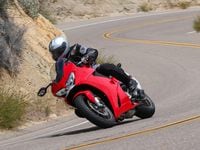
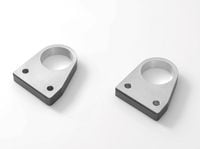
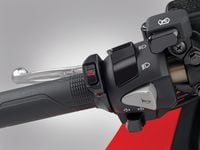

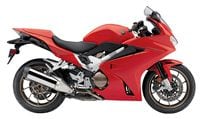

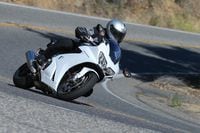


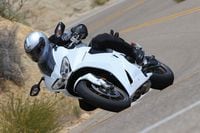
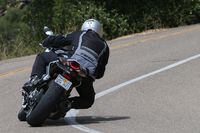
/cloudfront-us-east-1.images.arcpublishing.com/octane/MUQLOVLL2ZDGFH25ILABNBXKTI.jpg)
/cloudfront-us-east-1.images.arcpublishing.com/octane/TNOU5DNE2BC57MFPMGN2EIDXAM.jpg)
/cloudfront-us-east-1.images.arcpublishing.com/octane/GTCXACQGJ5HAPDTGWUQKDEH44E.jpg)
/cloudfront-us-east-1.images.arcpublishing.com/octane/S35YGSEMEZB4BLTDJTSZPF4GLA.jpg)
/cloudfront-us-east-1.images.arcpublishing.com/octane/5UOT6HPX2JFMRJAX6EH45AR4MQ.jpg)
/cloudfront-us-east-1.images.arcpublishing.com/octane/OKWOJWAKP5EP3OACCRRWPCIX2Q.jpg)
/cloudfront-us-east-1.images.arcpublishing.com/octane/2WF3SCE3NFBQXLDNJM7KMXA45E.jpg)
/cloudfront-us-east-1.images.arcpublishing.com/octane/G4MG6OUCJNBSHIS2MVVOTPX65E.jpg)
/cloudfront-us-east-1.images.arcpublishing.com/octane/IIGGWFOTOJGB7DB6DGBXCCMTDY.jpg)
/cloudfront-us-east-1.images.arcpublishing.com/octane/QSTCM6AVEZA5JJBUXNIQ3DSOF4.jpg)
/cloudfront-us-east-1.images.arcpublishing.com/octane/U4I7G625B5DMLF2DVIJDFZVV6M.jpg)
/cloudfront-us-east-1.images.arcpublishing.com/octane/B6XD6LS6IVCQPIU6HXDJSM3FHY.jpg)
/cloudfront-us-east-1.images.arcpublishing.com/octane/ICL63FEDDRDTTMINYICCEYGMDA.jpg)
/cloudfront-us-east-1.images.arcpublishing.com/octane/FCGZHQXRBZFLBAPC5SDIQLVF4I.jpg)
/cloudfront-us-east-1.images.arcpublishing.com/octane/WNOB6LDOIFFHJKPSVIWDYUGOPM.jpg)

/cloudfront-us-east-1.images.arcpublishing.com/octane/X33NU3E525ECRHXLNUJN2FTRKI.jpg)
/cloudfront-us-east-1.images.arcpublishing.com/octane/6KKT5NNL2JAVBOXMZYS5ZO76YA.jpg)
/cloudfront-us-east-1.images.arcpublishing.com/octane/J5RKG5O455GMPGQRF2OG6LRT7A.jpg)
/cloudfront-us-east-1.images.arcpublishing.com/octane/GX2CIZKQVRH2TATDM26KFG2DAE.jpg)
/cloudfront-us-east-1.images.arcpublishing.com/octane/ZWIDYSAKQZHD5BHREMQILXJCGM.jpg)
/cloudfront-us-east-1.images.arcpublishing.com/octane/CYUHJZCTSJCH3MRAQEIKXK7SCQ.jpg)
/cloudfront-us-east-1.images.arcpublishing.com/octane/LKOFINY56FCXJCANJ5M7ZDQUBY.jpg)
/cloudfront-us-east-1.images.arcpublishing.com/octane/4NBPDACMWJH63JQYJVK3QRBDZI.jpg)